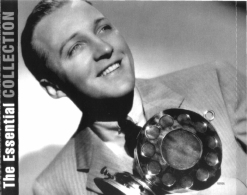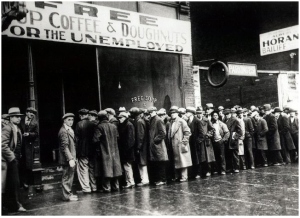Bing Crosby deserves a particular mention among modern artefacts. He was a genuine innovator who brought a modern approach to popular music. A key modernisation that Crosby utilised was the recently developed technology of electric recording. In the late twenties the recording of music was revolutionised by the introduction of the electric microphone, which, after teething problems, could reproduce the singer and musicians with what was amazing fidelity for the time. Previously singers had to stand in front of an acoustic horn and make sure they were loud enough, tending to produce a bellowing style such as in Al Jolson’s early records. Rapid advances in technology at this time made music increasingly accessible. The standard recording format for popular music had become the ten-inch 78 rpm shellac disc, which contained about three minutes of sound. The ten-inch had some mechanical and acoustic advantages, and was convenient to handle so that 78 rpm players became ubiquitous, and we came to think that three minutes was just right for a pop or dance piece. Radio networks also gained the advantage of greater fidelity and range, and people became glued to comedy and music programs. Hollywood musicals and dramas looked and sounded better, but films were still in black and white till the end of the decade.
Gary Giddins, a noted jazz and music critic from New York, in his biography of Bing Crosby credits him as the one who really took control of the microphone and made it his instrument. Crosby always came across as truly relaxed and this effect was enhanced by his perfection of an intimate and mellow style in his low register plus the ability to make use of lyrical vibrato and blue notes. His voice seemed to caress the microphone. He knew there was no need to shout.
the microphone and made it his instrument. Crosby always came across as truly relaxed and this effect was enhanced by his perfection of an intimate and mellow style in his low register plus the ability to make use of lyrical vibrato and blue notes. His voice seemed to caress the microphone. He knew there was no need to shout.
Taking advantage of the latest technology was something Crosby continued to do in later years (in the late 1940s), where he personally instigated the use of tape recording in America (importing the machines from Europe) and used tape for his radio shows so that they could be replayed on delay for the western states. Again, Gary Giddins:
“The more I began to research his life and realised the incredible impact he had on music, on cinema, on radio, on technology, the introduction of tape, the introduction of the microphone in nightclubs and so forth, I realised that this was the story through which I could really track the whole rise of technology in the media in the first half of the 20th century.”
Crosby’s easy command of rhythm and timing, which had a huge influence on the whole genre of popular music including the later Frank Sinatra, was learned through his ongoing association with jazz/swing people including Bix Beiderbecke (Mississippi Mud 1928), The Mills Brothers (Dinah 1931), Eddie Lang (many songs), Benny Goodman and Tommy Dorsey (My Honey’s Lovin’ Arms 1933), Frank Trumbauer (Love Me Tonight 1932) and others. He added his own jazzy embellishments by scat singing on Dinah and Sweet Georgia Brown 1932 (scat singing consists of syncopated vocal sounds like – ‘diddly abba dubba doodle dubba doo’ ). All of these are some of the tracks on the marvellous compact disc, The Essential Bing Crosby, Sony ‘Legacy’.
They used to tell me I was building a dream, and so I followed the mob,
When there was earth to plow, or guns to bear, I was always there right on the job.
They used to tell me I was building a dream, with peace and glory ahead,
Why should I be standing in line, just waiting for bread?
When Crosby sings Brother Can You Spare a Dime, virtually the theme song of the 30s Depression of the US and elsewhere, it sounds like a determined plea for justice for the unfortunate, and in these last couple of lines there is a touch of anger. That sympathetic tone fits in with his lack of pretension in his own life and his caring relationship with close friends. Crosby was just as convincing with romantic songs such as and Young and Healthy and Love Me Tonight, where the sweet suggestions of seduction could have made young girls blush in 1932. In all, at this stage of his career he was a consummate artist with vitality and character that made him a one-off. In later years it seems the studios wanted a blander more syrupy style, which would sell well but would lack his original musicality.
http://www.youtube.com/watch?v=ovndTa7hQDE

Thanks. Pleased to have found your eclectic blog and I’ll return to read more. Regards from Thom at the immortal jukebox (drop a nickel sometime!)